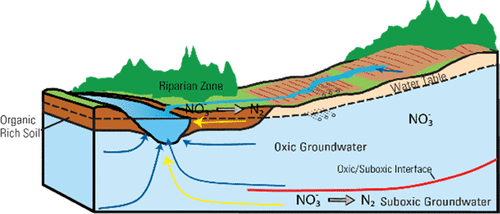当前位置:
X-MOL 学术
›
Environ. Sci. Technol.
›
论文详情
Our official English website, www.x-mol.net, welcomes your
feedback! (Note: you will need to create a separate account there.)
Factors Affecting Nitrate Concentrations in Stream Base Flow
Environmental Science & Technology ( IF 10.8 ) Pub Date : 2020-12-24 , DOI: 10.1021/acs.est.0c02495 Susan A. Wherry 1 , Anthony J. Tesoriero 1 , Silvia Terziotti 2
Environmental Science & Technology ( IF 10.8 ) Pub Date : 2020-12-24 , DOI: 10.1021/acs.est.0c02495 Susan A. Wherry 1 , Anthony J. Tesoriero 1 , Silvia Terziotti 2
Affiliation

|
Elevated nitrogen concentrations in streams and rivers in the Chesapeake Bay watershed have adversely affected the ecosystem health of the bay. Much of this nitrogen is derived as nitrate from groundwater that discharges to streams as base flow. In this study, boosted regression trees (BRTs) were used to relate nitrate concentrations in base flow (n = 156) to explanatory variables describing nitrogen sources, geology, and soil and catchment characteristics. From these relations, a BRT model was developed to predict base flow nitrate concentrations in streams throughout the Chesapeake Bay watershed. The highest base flow nitrate concentrations were associated with intensive agricultural land use, carbonate geology, and sparse riparian canopy, which suggested that reduced nitrogen inputs, particularly over carbonate terrane, are critical for limiting nitrate concentrations. The lowest nitrate concentrations in the BRT model were associated with extensive riparian canopy, high levels of organic carbon in soils, and suboxic conditions at shallow depths, which suggested that denitrification in the subsurface, particularly in the riparian zone, is limiting base flow nitrate concentrations. Nitrate transport from aquifers to streams can take decades to occur, resulting in decades-long lag times between the time when a land-use activity is implemented and when its effects are fully observed in streams. Predictive models of base flow nitrate concentrations in streams will help identify which portions of a watershed are likely to have large fractions of total stream nitrogen load derived from pathways with significant lag times.
中文翻译:

流基流中影响硝酸盐浓度的因素
切萨皮克湾流域的溪流和河流中的氮含量升高,对该湾的生态系统健康产生了不利影响。这种氮的大部分是从地下水中以硝酸盐形式产生的,并作为基本流量排放到溪流中。在这项研究中,使用增强回归树(BRT)关联基流中的硝酸盐浓度(n= 156)来解释变量,描述氮源,地质,土壤和集水区特征。根据这些关系,开发了BRT模型,以预测整个切萨皮克湾流域中溪流中基流硝酸盐的浓度。最高的基流硝酸盐浓度与集约型农业土地利用,碳酸盐地质和稀疏的河岸冠层有关,这表明减少的氮输入,特别是碳酸盐岩土上方的氮输入,对于限制硝酸盐浓度至关重要。BRT模型中最低的硝酸盐浓度与广泛的河岸冠层,土壤中高水平的有机碳以及浅深度的亚氧化条件有关,这表明地下特别是河岸带的反硝化作用限制了基本流量硝酸盐浓度。硝酸盐从含水层到河流的运输可能需要数十年的时间,导致实施土地利用活动的时间与在河流中充分观察到其影响之间的滞后时间长达数十年。河流中基本流量硝酸盐浓度的预测模型将有助于确定流域的哪些部分可能具有很大的总氮流量,其中总氮流量源自具有显着滞后时间的路径。
更新日期:2021-01-19
中文翻译:

流基流中影响硝酸盐浓度的因素
切萨皮克湾流域的溪流和河流中的氮含量升高,对该湾的生态系统健康产生了不利影响。这种氮的大部分是从地下水中以硝酸盐形式产生的,并作为基本流量排放到溪流中。在这项研究中,使用增强回归树(BRT)关联基流中的硝酸盐浓度(n= 156)来解释变量,描述氮源,地质,土壤和集水区特征。根据这些关系,开发了BRT模型,以预测整个切萨皮克湾流域中溪流中基流硝酸盐的浓度。最高的基流硝酸盐浓度与集约型农业土地利用,碳酸盐地质和稀疏的河岸冠层有关,这表明减少的氮输入,特别是碳酸盐岩土上方的氮输入,对于限制硝酸盐浓度至关重要。BRT模型中最低的硝酸盐浓度与广泛的河岸冠层,土壤中高水平的有机碳以及浅深度的亚氧化条件有关,这表明地下特别是河岸带的反硝化作用限制了基本流量硝酸盐浓度。硝酸盐从含水层到河流的运输可能需要数十年的时间,导致实施土地利用活动的时间与在河流中充分观察到其影响之间的滞后时间长达数十年。河流中基本流量硝酸盐浓度的预测模型将有助于确定流域的哪些部分可能具有很大的总氮流量,其中总氮流量源自具有显着滞后时间的路径。











































 京公网安备 11010802027423号
京公网安备 11010802027423号